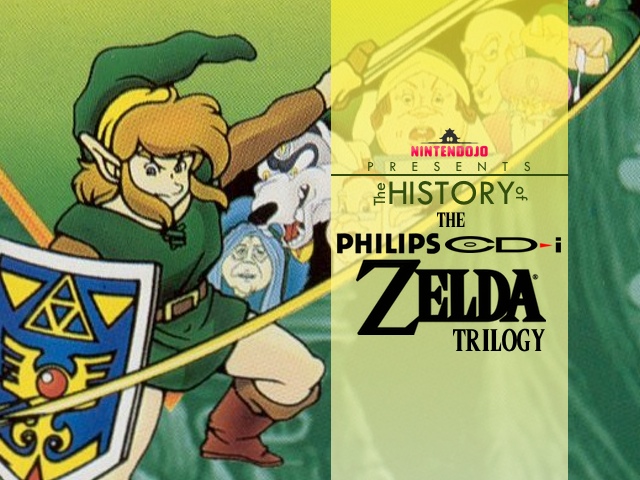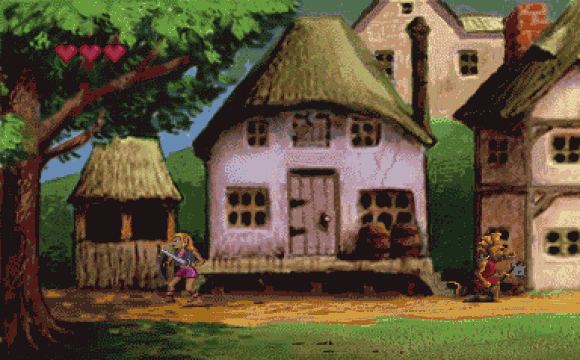
Fans know quite a bit these days about the failed attempt in the late 80s/early 90s by electronics maker Sony to produce video game hardware with Nintendo; that botched experiment would serve to spur Sony into striking out solo with its own system dubbed PlayStation, resulting in one of the biggest thorns in Nintendo’s side for the next two console generations. Another company, however, had also tried to court a hardware-building relationship with the Big N after the Sony collapse, and that was electronics giant Philips. The company was no stranger to the video game market; indeed, the first commercial video game console ever released was by Philips’ subsidiary Magnavox, called the Magnavox Odyssey. The two companies were also not unfamiliar to each other, as Nintendo had been the distributor of the Magnavox Odyssey in Japan. That would all seem to be a mark in Philips’ favor, but sadly the company’s track record as a video game hardware and software maker was rocky, at best.
The followup to its first console was Magnavox Odyssey 2 (or the Philips Videopac G7000 for our Euro readers), and its lifetime on the market was haunted by repeated attempts on the part of Philips to cease its production. Spotty marketing and software development support plagued Magnavox Odyssey 2 from its inception, and though it would go on to sell over a million units by 1983, the system never was able to reach the same success that its competitors the Atari 2600 and Mattel Intellivision enjoyed. Even in the days before the great video game crash of the ’80s, Philips simply couldn’t perceive the potential of the industry, and its cold feet cost Magnavox Odyssey 2 any shot it ever had at being a contender.
Regardless, in the years following the meteoric rise of Nintendo after the releases of its Nintendo Entertainment System and then Super Nintendo Entertainment System, Philips clearly started to come around to the whole “video game” idea and wanted back in with the industry. With visions of a bright future partnering to work on SNES, Philips attempted to join with Nintendo to bring a CD-ROM add-on to the 16-bit console, but would ultimately come to fare no better than Sony. The primary problem was that Nintendo had became antsy about the prospects of a potential CD-based peripheral device after witnessing the failure of Sega’s own add-on to its Genesis console, and along with a handful of other trepidations, the company came to pull the plug on Philips just as it had done with Sony.
After the deal failed to come to fruition, Philips decided it didn’t want to waste the effort it had expended working with Nintendo, and would go on to build its own gaming system much like Sony had; after all, Philips had done it before, so there was reason internally to believe it could do so again. Unlike Sony, however, Philips negotiated with Nintendo after the hardware deal imploded to have some of the latter’s characters appear in games for its new console, dubbed Philips CD-i. Three of the characters settled upon were Link, Zelda, and Ganon, along with a big chunk of the Super Mario Bros. franchise. Sadly, the deficiencies that had sidelined Philips in its original endeavors as game producers would seemingly return and scuttle any hopes of the company ever becoming a real player at the table again.

Philips farmed out production of its Zelda games to third-party developer Animation Magic, supplying the studio with reference imagery it had received from Nintendo of that company’s first two Zelda games in order to create the look of the characters, and stipulated that all the features of CD-i were to be utilized in the end product. Nintendo’s involvement in the projects was entirely cursory, offering minimal input seeing as the development of the titles was completely out of its control. Unfortunately CD-i, despite Philips’ ambitions to re-enter the market, was never created with the full intent of being a dedicated gaming platform, but more of a media playing device like a VCR, instead. As a result, all three of its Zelda titles would go on to be plagued with control and performance issues. For the era, there was a buzz around the quality of the FMV animation that was afforded by the system’s CD-ROM infrastructure, but it wasn’t enough to ever make the CD-i a big seller.
Three Zelda games were produced under the deal between Nintendo and Philips: Link: The Faces of Evil and Zelda: The Wand of Gamelon were the first two, developed by Animation Magic and played from a 2D perspective reminiscent of Zelda II. The last title, Zelda’s Adventure, was produced by a company called Viridis, which brought an overhead perspective more in line with the original Zelda and A Link to the Past. (For those interested, Philips’ Mario game was Hotel Mario, developed in-house and just as awful as the Zelda games the company produced!) Though the trio of games weren’t universally panned upon their release, in the years since these three titles have come under massive fire by critics and Zelda purists. The ire from fans is most fascinating, because if numbers are anything to go off of (remember, the CD-i didn’t sell well), one can’t help but wonder how many of them have actually ever even played these games. Not that a person needs to see a skunk to smell a skunk, but I digress…
Part of the problem with The Faces of Evil and The Wand of Gamelon is that both titles suffered from jerky controls. It’s ironic how Nintendo, many years before the release of either of Philips’ two titles, had nailed in Zelda II the side-scrolling mechanics that Animation Magic struggled with– on more technologically powerful hardware, no less. Even with the switch of studios to Viridis and a change of perspective for Zelda’s Adventure, Philips was met with the same middling results. A portion of the blame must be allocated to the CD-i console itself; along with the issues with the platform’s internal architecture, its controllers were notorious for being incapable of keeping up with the demands of basic game playing. It’s also apparent, however, that neither Philips nor either of the development studios that worked on the three Zelda titles had the wherewithal to produce quality video games. Even the animation that was so lauded by proponents of the games at the time was only really impressive from a technical standpoint; taken on their own, the movies are unwittingly hilarious because of how awful they are.
Still, there’s no denying, even if judging based on footage of the in-game videos or the gameplay alone, that the end result of these three Zelda titles was pretty grating, and clearly nowhere near the polish that Nintendo is known for. Philips crippled Magnavox Odyssey 2 with its waffling commitment to the device, and though the company eventually got another chance at making games with CD-i, it’s plain that it didn’t have the vision needed to match its ambition. Nintendo itself never mentions the CD-i Zelda games in any way, despite their legitimate, official licensing. For completionists, the lure of owning these three titles is hard to resist, but getting hold of any of the lot is no easy feat– or at least, not a cheap one. Complete sets of the games can easily fetch upwards of a few hundred dollars from secondary market vendors, and even the cheapest, most incomplete copies cost north of forty dollars apiece. Whether they’re actually worth that much is in the eye of the collector, but as a historical curiosity, the Zelda CD-i trilogy is an intriguing chapter in the lineage of the Legend of Zelda franchise, if for no other reason than that it provided the first two Zelda games to actually star the princess herself!




 ShareThis
ShareThis






Very dark sheep games, indeed. These games are turds for a reason. I remember seeing them at some store, trying to play one; then walking away. If you are a serious Zelda junkie, I suppose they are worth adding to your collection. I understand how that is, but these I skipped and forgot. Until this article reminded me of those days.
Buy hey, I have to add; great article! Blast from the past for sure.
Nice article, and some good history details I didn’t know. It’s wild to think Phillips negotiated for character rights _after_ the hardware deal fell through!
I actually played a CD-i, though not any of the Zelda games. As stated here, it was more of an AV tool than a game console. The one I used belonged to a high school library. I’ve seen photos of more game-shaped CD-i controllers, but the thing I used was absolutely atrocious even for navigating menus and putting together custom storyboard sequences, which was about all I could do in those handful of edutainment discs which took forever and a day to load.
(I tried to link a picture of the awful controller but my post got discarded.)
I can only extrapolate on my own experience and imagine how awful it would be to try to play an action game on that machine. It wasn’t just the controller’s shape or the squishy directional stick either — all inputs felt excruciatingly delayed. PS3-to-PSP remote play with the largest buffer setting is snappy by comparison. Online lag has nothing on the crappiness of that wired CD-i controller.
I know what you mean about that system. Remember the Atari Jaguar? The 3DO? Other systems which shall remain nameless? Or the add-ons for Sega? I suppose Nintendo at the time made a wise move in abandoning add-ons for the NES, SNES, and N64. Japan got those, but we didn’t. As I’ve said before, the one mistake they made was screwing over Sony with the Play Station. Hindsight is 20/20 though, and at the time Sega was bombing with all their various add-ons. If only they could go back in time!
Penduin: Regarding your picture, we have issues with spam bots, so comments that contain links are automatically held for moderation. I go through those comments often, though, so if I see one from an actual user, then I’ll approve it. :)
(I was going to approve your original comment, but by the time I noticed it you had already posted it again without the link, so I figured there wouldn’t be a point to approving it. So sorry!)
Heh no problem, I assumed it was something like that. Everyone here is perfectly capable of searching for CD-i controller pictures themselves and raising an eyebrow at the monstrosity I remember using. :^)